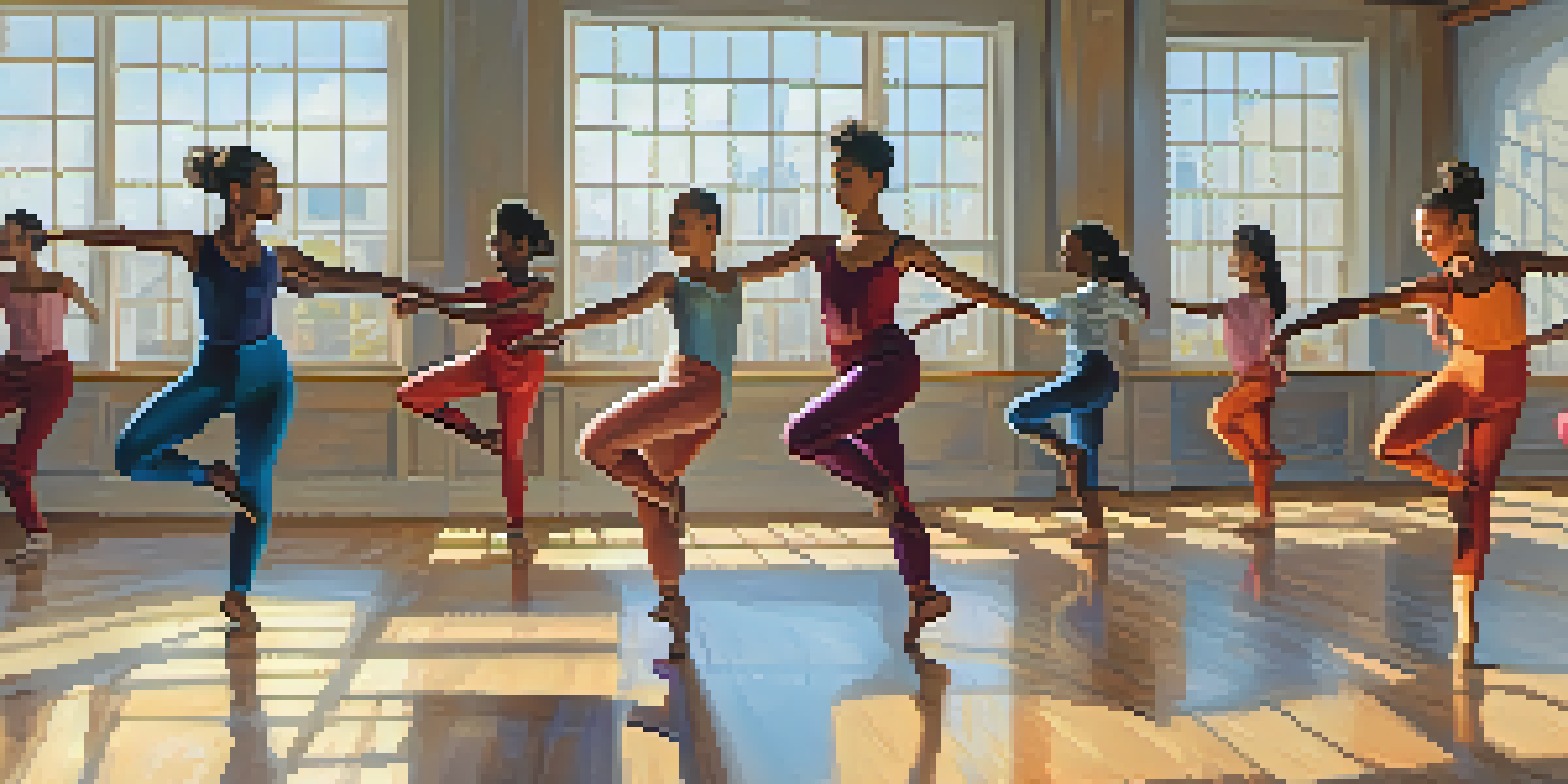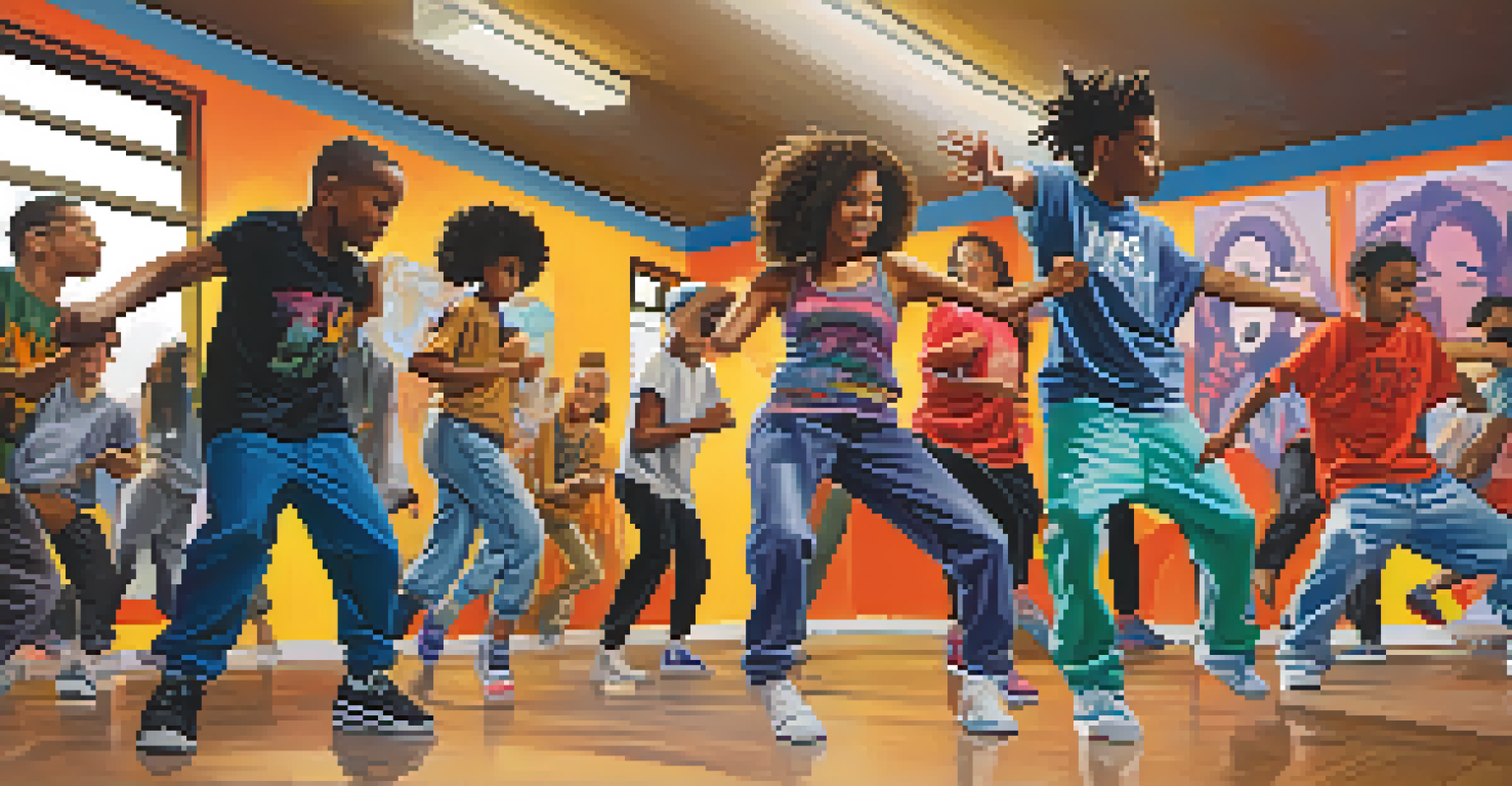Dance Programs: Building Skills and Confidence in Youth

The Transformative Power of Dance for Youth
Dance is more than just movement; it's a powerful tool for personal growth. Engaging in dance programs allows youth to express themselves creatively, developing both their artistic abilities and emotional intelligence. This form of expression can be particularly beneficial for young people, providing an outlet for their thoughts and feelings.
Dance is the hidden language of the soul.
As children learn various dance styles, from ballet to hip-hop, they also discover new ways to communicate and connect with others. This connection through dance fosters a sense of belonging, which is crucial during the often tumultuous teenage years. The joy of dancing with peers can create lasting friendships and support networks.
Moreover, the discipline required in dance helps youth build a strong work ethic. Regular practice and commitment to improvement teach them the importance of perseverance, which translates into other areas of their lives, such as academics and personal relationships.
Building Essential Life Skills Through Dance
Participating in dance programs helps youth develop essential life skills that extend beyond the dance floor. These skills include teamwork, communication, and leadership, all of which are vital in our interconnected world. When young dancers work together on group routines, they learn to collaborate effectively and appreciate the contributions of others.

Additionally, dance fosters problem-solving skills. Choreography often requires dancers to think creatively and adapt to new challenges, whether it's perfecting a routine or overcoming stage fright. This ability to navigate obstacles can empower youth to tackle challenges in their everyday lives with confidence.
Dance Enhances Emotional Growth
Engaging in dance allows youth to express their emotions creatively, fostering emotional intelligence and resilience.
Finally, dance programs encourage goal-setting and achievement. Whether it's mastering a tricky dance move or preparing for a performance, young dancers learn to set realistic goals and celebrate their progress. This sense of accomplishment builds confidence and motivates them to pursue future aspirations.
Boosting Self-Confidence Through Dance
One of the most profound impacts of dance programs on youth is the boost in self-confidence they provide. As students practice and perform, they gain a sense of accomplishment that enhances their self-esteem. Each successful performance, no matter how small, reinforces their belief in their abilities.
Dance is the joy of movement and the heart of life.
Moreover, dance encourages body positivity. As youth learn to appreciate their bodies for what they can do rather than how they look, they cultivate a healthier self-image. This shift is particularly important in a society that often promotes unrealistic standards of beauty.
Participating in dance also creates a safe space where youth can embrace their individuality. In classes, they are encouraged to express their unique styles and personalities, which fosters a sense of acceptance and pride in who they are.
Fostering Emotional Intelligence Through Movement
Dance is a unique form of expression that allows youth to explore and understand their emotions. Through movement, they can convey feelings that may be difficult to articulate verbally. This exploration helps them develop emotional intelligence, an essential skill for navigating life’s challenges.
In dance classes, young people learn to interpret music and express emotions through their bodies. This ability to connect with music on a deeper level enhances their emotional awareness and empathy toward others. As they dance, they also learn to read the emotional cues of their peers, fostering better interpersonal relationships.
Dance Builds Life Skills
Participation in dance programs helps youth develop essential skills like teamwork, communication, and problem-solving.
Additionally, dance encourages resilience. When facing setbacks, such as forgetting a routine or feeling nervous before a performance, youth learn to cope with these challenges. Developing coping strategies in a supportive environment can empower them to handle future adversities with grace.
Encouraging Cultural Awareness Through Dance
Dance programs often expose youth to a variety of cultural styles, enhancing their understanding and appreciation of different traditions. This exposure fosters cultural awareness and sensitivity, encouraging young dancers to embrace diversity. Understanding the history and significance behind various dance forms can broaden their perspectives.
Participating in multicultural dance classes helps youth connect with their own cultural heritage while learning about others. This blend of experiences promotes inclusivity and respect for different backgrounds, forming a more harmonious community. It allows them to see the beauty in diversity and value the unique stories each culture brings.
Moreover, dance can serve as a bridge between generations. When youth learn traditional dances from their families or communities, they create lasting connections with their heritage. This intergenerational exchange fosters pride in one’s culture and ensures that these rich traditions are passed down.
Creating Lasting Friendships and Community Bonds
Dance programs are often a hub for social interaction, where young people can form lasting friendships. The shared experience of learning and performing together creates a strong sense of camaraderie. These relationships can provide invaluable support during the ups and downs of growing up.
In addition to friendships, dance programs foster a sense of community. Young dancers often participate in local performances and events, bringing families and friends together to celebrate their achievements. This creates a sense of belonging and pride, as the community rallies around its youth.
Community and Friendship Through Dance
Dance programs create a sense of belonging, allowing young people to form lasting friendships and community bonds.
Furthermore, the bonds formed in dance classes can extend beyond the studio. Many dancers find that the skills they learn in teamwork and collaboration translate into their other social circles, making them more engaged and confident members of society.
The Importance of Professional Guidance in Dance Programs
Having skilled instructors is crucial in dance programs, as they guide youth through their journey in dance. Professional teachers not only provide valuable technical skills but also serve as mentors, helping students navigate their personal and artistic development. Their support can inspire confidence and a love for dance that lasts a lifetime.
Instructors play a key role in creating a supportive environment where youth feel safe to express themselves. By fostering a culture of encouragement and positivity, they help students overcome fears and take risks in their dancing. This nurturing atmosphere is essential for building resilience and self-assurance.

Moreover, professional guidance ensures that youth learn proper techniques and safety measures. This focus on health and wellness helps prevent injuries and promotes a lifelong love for movement. With the right support, young dancers can thrive both physically and emotionally.